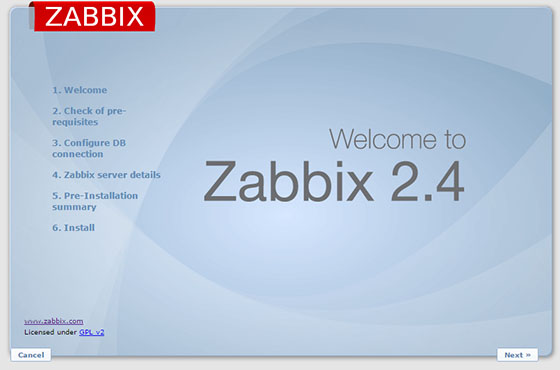
In this tutorial, we will show you how to install Zabbix on Ubuntu 14.04. For those of you who didn’t know, Zabbix is an open-source monitoring tool that is ideal for monitoring your cloud servers. Zabbix is very flexible, information can be retrieved using HTTP/SNMP or by installing a Zabbix agent on the machines to monitor, and allows a lot of customization.
This article assumes you have at least basic knowledge of Linux, know how to use the shell, and most importantly, you host your site on your own VPS. The installation is quite simple and assumes you are running in the root account, if not you may need to add ‘sudo‘ to the commands to get root privileges. I will show you the step-by-step installation of the Zabbix on Ubuntu 14.04.
Prerequisites
- A server running one of the following operating systems: Ubuntu 14.04, and any other Debian-based distribution.
- It’s recommended that you use a fresh OS install to prevent any potential issues.
- SSH access to the server (or just open Terminal if you’re on a desktop).
- A
non-root sudo useror access to theroot user. We recommend acting as anon-root sudo user, however, as you can harm your system if you’re not careful when acting as the root.
Install Zabbix on Ubuntu 14.04
Step 1. First of all, make sure that all packages are up to date.
apt-get update apt-get upgrade
Step 2. Install the LAMP server and include some PHP extensions.
sudo apt-get install apache2 sudo apt-get install mysql-server sudo apt-get install php5 php5-cli php5-common php5-mysql
Start service Apache web server and MySQL also enable it to start on boot of the server:
/etc/init.d/apache2 start /etc/init.d/mysql start
Step 3. Install Zabbix
Adding apt repository:
wget http://repo.zabbix.com/zabbix/2.2/ubuntu/pool/main/z/zabbix-release/zabbix-release_2.2-1+trusty_all.deb sudo dpkg -i zabbix-release_2.2-1+trusty_all.deb sudo apt-get update
After adding Zabbix apt repository in your system, Now update package lists and install Zabbix using commands:
sudo apt-get install zabbix-server-mysql zabbix-frontend-php
Step 4. Zabbix Configuration.
sudo nano /etc/zabbix/zabbix_server.conf
Adjust the following values and make a note of the password you’ve chosen. You’ll need it later too.
DBName=zabbix DBUser=zabbix DBPassword=your_chosen_password_here
Step 5. Configure MySQL Database for Zabbix.
By default, MySQL is not hardened. You can secure MySQL using the mysql_secure_installation script. you should read and below each step carefully which will set a root password, remove anonymous users, disallow remote root login, and remove the test database and access to secure MySQL.
mysql_secure_installation
Next, we will need to log in to the MySQL console and create a database for Zabbix. Run the following command:
mysql -u root -p
This will prompt you for a password, so enter your MySQL root password and hit Enter. Once you are logged in to your database server you need to create a database for the Zabbix software:
create user 'zabbix'@'localhost' identified by 'your_chosen_password_here'; create database zabbix; grant all privileges on zabbix.* to 'zabbix'@'localhost'; flush privileges; exit;
Next, we’ll import the schemas into the newly created database:
mysql -u zabbix -p zabbix < schema.sql mysql -u zabbix -p zabbix < images.sql mysql -u zabbix -p zabbix < data.sql
Step 6. Configure Apache web server for Zabbix.
First, we’ll move the Zabbix apache file from the package directory:
sudo cp /usr/share/doc/zabbix-frontend-php/examples/apache.conf /etc/apache2/conf-available/zabbix.conf sudo a2enconf zabbix.conf sudo a2enmod alias
Edit the Zabbix init file to ensure that it performs the correct action:
### sudo nano /etc/default/zabbix-server START=yes
We should adjust php.ini file as per Zabbix recommended settings:
### sudo nano /etc/php5/apache2/php.ini post_max_size = 16M max_execution_time = 300 max_input_time = 300 date.timezone = "Europe/London"
Next copy the example config to the /etc/zabbix directory. Then make the necessary adjustments too:
sudo cp /usr/share/doc/zabbix-frontend-php/examples/zabbix.conf.php.example /etc/zabbix/zabbix.conf.php ### sudo nano /etc/zabbix/zabbix.conf.php $DB['DATABASE'] = 'zabbix'; $DB['USER'] = 'zabbix'; $DB['PASSWORD'] = 'your_chosen_password_here'
Restart the Apache and Zabbix service for the changes to take effect:
sudo service zabbix-server restart sudo service apache2 restart
Step 7. Accessing Zabbix.
Zabbix will be available on HTTP port 80 by default. Open your favorite browser and navigate to http://yourdomain.com/zabbix or http://server-ip/zabbix and complete the required steps to finish the installation. If you are using a firewall, please open port 80 to enable access to the control panel.

Congratulations! You have successfully installed Zabbix. Thanks for using this tutorial for installing Zabbix Monitoring Tool on Ubuntu 14.04 system. For additional help or useful information, we recommend you check the official Zabbix website.